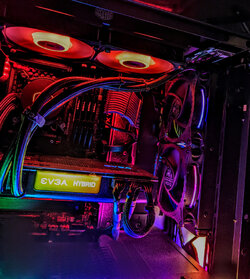- Joined
- Mar 24, 2016
It never occurred to me before to use two AIO, but would it be feasible? I currently have a Corsair AIO for my CPU wih the radiator top mounted and fans blowing up and out.
If I had a GPU AIO, I would have to front mount it with the fans....as intake blowing in??
Are there AIO that have 2 blocks for both CPU and GPU??
If I had a GPU AIO, I would have to front mount it with the fans....as intake blowing in??
Are there AIO that have 2 blocks for both CPU and GPU??
 I resemble that remark.
I resemble that remark.
 I purchased 2 evga 360 aio's as replacements. TO THE OP - If you are looking to run a GPU AIO on a nvidia card, I would recommend a NZXT G12 cooler (
I purchased 2 evga 360 aio's as replacements. TO THE OP - If you are looking to run a GPU AIO on a nvidia card, I would recommend a NZXT G12 cooler ( 